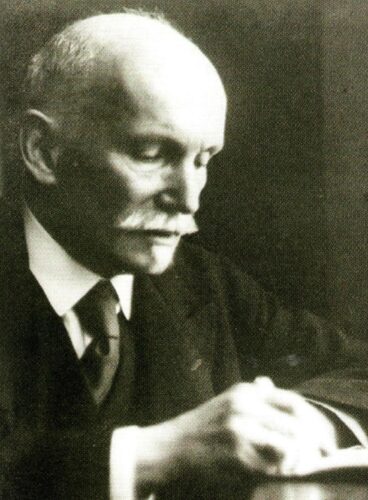Prof. Dr. med. Ernst Neisser
- Liegnitz/Legnica, Lower Silesia, Poland, 16.05.1863
- Berlin, 04.10.1942
- Member since 1928
- Szczecin
- Specialist in internal medicine
Ernst Neisser was born in former Liegnitz/Legnica, Lower Silesia, in 1863 as the son of the merchant Salomon Neisser and his wife Julie, née Sabersky. His brother was the Frankfurt bacteriologist Max Neisser.
Education and Further Training
Neisser attended the municipal grammar school in his home town, from which he graduated on Easter 1883. He studied medicine in Berlin, Breslau, Freiburg, and Heidelberg, where he passed the state examination in February 1888. He received his doctorate from the University of Berlin in April of the same year with the thesis “Beiträge zur Kenntnis des Glykogens”, which he had written under Paul Ehrlich at the Medical Clinic of the Charité in Berlin. He worked for Robert Koch and Carl Fraenkel at the Institute for Hygiene at the Charité after having passed his state examination. Neisser’s interest in infectious diseases was a constant throughout his career. Neisser moved to Ludwig Lichtheim at the Medical Clinic of the University of Königsberg in 1890. There he habilitated in internal medicine in 1893 with a thesis on “Über die gegenwärtige Bedeutung des Tierversuches für die Lehre von den Infektionserkrankungen“.
Ernst Neisser was the first to document the corynebacterium diphtheriae (“loeffler bacillus”) in the tissue of a cutaneous manifestation of diphtheria in 1891.
Place of Work Stettin
Ernst Neisser, who had a strong scientific orientation, was the medical director of the Department of Internal Medicine at the Stettin Municipal Hospital for 36 years, from 1895 to 1931. He left a lasting mark on the department. During this time he expanded the medical clinic from an initial 160 beds in 1895 to 400 beds in 1931. He established his own chemical laboratory and initially devoted special attention to bacteriological issues and infectious diseases. He set up a diphtheria examination ward, dealt with typhus – that was rampant in Stettin at the time – and together with his senior physician Hermann Braeuning, was an early promoter of founding special tuberculosis hospitals for patients with all stages of the disease. The Hohenkrug/Zdunowo tuberculosis hospital that opened in a district of Szczecin in 1915 can be traced back to Neisser’s plans. He was one of the pioneers of early systematic strategies against tuberculosis.
The polyclinic assigned to the department was transformed into a “prophylactic institute” and later into an “institute for continuous observation of the sick”, where patients who had been discharged were monitored.
Together with Kurt Pollack, Neisser described a new diagnostic and therapeutic method for brain and lumbar puncture in 1904. He also worked on pernicious anaemia, lead and arsenic intoxication, metabolic pathology, especially diabetes mellitus and coma in liver cirrhosis. Neisser advocated the administration of very small doses of iodine in Graves’ disease in 1920.
Fritz Schlesinger, who settled in Stettin in 1919 as a specialist in gastrointestinal and metabolic diseases, was one of his senior physicians.
Ernst Neisser completed his clinical work in Stettin in 1931 at the age of 68. He then ran a sanatorium in Bad Altheide, Lower Silesia (now Polanica-Zdrój, Poland), which he was forced to leave in 1933 under pressure from the National Socialists.
The Neissers’ son Peter, died in Heidelberg in 1929 at the age of 23. Their daughter Susan Vogel survived the Holocaust. The art historian Hans Vogel was Neisser’s son-in-law. Neisser was extremely interested in music and was a gifted pianist himself.
Berlin since 1933
Neisser had lived in Berlin since 1933, where he ran a small practice until 1938. With persecution by the National Socialists increasing, friends in Sweden, supported by Karl Bonhoeffer and Otto Hahn, tried to enable the Neissers to leave Germany, which was initially unsuccessful. The artist Edith Junghans-Hahn, who came from Stettin, and her husband, the chemist and atomic researcher Otto Hahn, cultivated a friendship with the Neissers. Neisser’s wife, Margarethe, née Pauly, took her own life in October 1941 in the Westend sanatorium in Berlin-Charlottenburg as a result of mental illness.
Ernst Neisser learned of his impending deportation to the Theresienstadt ghetto on 30 September 1942. The news about an entry visa to Sweden arrived too late.
Ernst Neisser died at the Jewish Hospital in Berlin on 4 October 1942 at the age of 79, after having deliberately taken an overdose of sleeping pills.
The medical historian Erwin Ackerknecht, who had studied internal medicine with Ernst Neisser in 1926, described him as a highly competent clinician with a strong scientific interest, a good diagnostician and sensitive therapist, and “a most humane doctor”.
Acknowledgements
We are grateful to Ernst Neisser’s granddaughter, Agnes Stieda, Canada, and his great-granddaughter Nicki Stieda, also living in Canada, for providing important documents, valuable biographical information, and numerous photographs.
We would also like to thank Richard Brook, USA, for putting us in touch with Agnes Stieda’s family, and Julia Drinnenberg, Jewish Museum Hofgeismar, for fruitful discussions.
Sources and Further Reading
Sources





